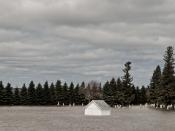Writer: Linber LewisSchool: President's College, GuyanaIf one asks the question, ÃÂwhat can floods do?ÃÂ, then the following may seem like fitting answers. During the summer monsoon season, heavy rains cause destructive floods in Southeast Asia. In China, the floods of the Huang He River have been so frequent and devastating that the river is called ÃÂChinaÃÂs SorrowÃÂ. Likewise in the US, record spring and summer rains in 1993 caused the Mississippi Rover to overflow its banks, flooding farms and towns from North Dakota to Missouri, causing 10 billion dollars in damages and leaving 70, 000 homeless.
These extracts attest to the destructive nature of floods. By contrast, Britannica Encyclopedia tells us that the success of the Egyptian Civilization was heavily dependent on the annual flooding of the Nile to replenish soil moisture and fertility, and also to supply to irrigation water.
Since plants and animals are a part of human life, once can assume that if floods affect us they will affect them (plants and animals) also, whether positively or negatively.
Research shows that domestic animals seem to suffer greatly during conditions of excess water. According to the book, ÃÂWhere there is no VetÃÂ; ÃÂthe infectious disease foot rot that attacks the hooves of animals, is prevalent during wet weather and in wet areas.ÃÂ It is known that floods bring a sharp increase in insect population. Consequently animals suffer from skin and eye irritations due to these insects. According to the Government Information Agency (GINA), during the 2005 flood, more than 2000 animals were treated during the early stages of the floods. They were treated for worms, diarrhea, nutritional deficiency, and respiratory and skin problems. The shortage of food had also affected animals. GINA also stated that feed and molasses were distributed. According to a Stabroek news article dated 05/02/16,



Sources are identified within the review
The sources are identified withing the review such as Nature Encylopedia etc.
0 out of 0 people found this comment useful.